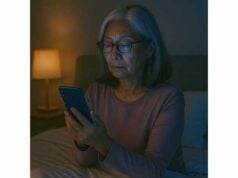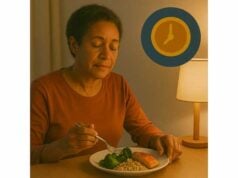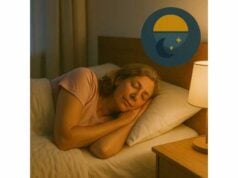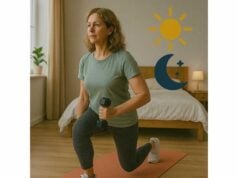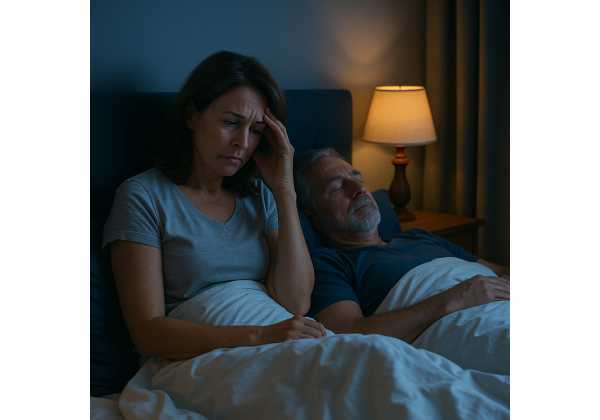
Midlife brings real biological shifts that touch nearly every system tied to sleep. Estrogen and progesterone decline during menopause; testosterone may drift lower during andropause. Core temperature control changes, airway tone can weaken, and mood and metabolism become more reactive to short nights. None of this is a personal failure. It is physiology—and it is manageable with the right levers. This guide explains how hormones affect sleep architecture and circadian timing, why hot flashes and night sweats derail continuity, and how snoring and sleep apnea risk change for women and men. You will also find practical, non hormonal tactics, clear criteria for when to discuss hormone therapy, and a simple method to track progress. If you are building a broader plan that aligns sleep, stress, and recovery across the decades, visit our foundation on longevity-focused sleep and stress strategies to round out the approach.
Table of Contents
- How Hormonal Shifts Disrupt Sleep Across Midlife
- Night Sweats, Hot Flashes, and Thermoregulation at Night
- Snoring and Sleep Apnea Risk in Menopause and Andropause
- Non Hormonal Sleep Strategies That Help
- Exercise, Meal Timing, and Evening Routines for Better Sleep
- When to Discuss Hormone Therapy with a Clinician
- Tracking Progress: Sleep Quality, Mood, and Recovery
How Hormonal Shifts Disrupt Sleep Across Midlife
Sleep is not a single switch. It emerges from an interplay of circadian timing, sleep pressure, thermoregulation, and arousal balance. Hormones modulate each of these. During the menopausal transition, estradiol and progesterone fall and fluctuate. Estradiol affects serotonin, acetylcholine, and thermoregulation; progesterone’s metabolites interact with GABA receptors and often feel calming. As both decline, many experience lighter sleep, more frequent awakenings, and a shift toward earlier morning arousal. In men, progressive reductions in bioavailable testosterone may correlate with sleep fragmentation and lower slow-wave sleep, although weight gain and airway anatomy often play larger roles.
Hot flashes (vasomotor symptoms) illustrate how endocrine changes disturb continuity. A sudden hypothalamic “narrowing” of the thermoneutral zone makes minor temperature excursions feel like overheating. The body responds with peripheral vasodilation and sweating; heart rate rises, and arousal systems spike. The flash passes, but the awakening often lingers—especially if room temperature is high or bedding traps heat. Over weeks, repeated disruptions erode total sleep time and degrade next-day mood and cognition.
Circadian timing also drifts. Diminished evening melatonin amplitude and inconsistent light exposure (especially bright screens after dusk) make it harder for the brain to predict sleep. Many midlife adults report a “second wind” at 10–11 p.m. that pushes bedtime later while wake time stays fixed for work or caregiving, reducing sleep opportunity.
Pain, mood, and metabolism add friction. Joint pain, tension headaches, reflux, and nocturia rise with age and interrupt the night. Anxiety and low mood magnify threat detection near lights-out, prolonging latency. Glucose regulation becomes more sensitive to late meals and short nights, increasing nocturnal awakenings for some.
The net effect is a feedback loop: worse sleep amplifies stress reactivity and appetite signals; elevated stress and late eating further disrupt sleep. Breaking that loop rarely requires perfection. It requires identifying your main bottlenecks—heat surges, airway issues, timing drift, or arousal—and applying targeted tools over two to four weeks to measure what actually changes.
Night Sweats, Hot Flashes, and Thermoregulation at Night
Vasomotor symptoms (VMS)—hot flashes and night sweats—are the most common sleep disruptors in the menopausal transition. They can occur dozens of times per week, with intensity ranging from mild warmth to drenching sweats that require changing clothes. Each event is a small storm: skin blood flow surges, heart rate ticks up, and a brief sympathetic spike collides with the sleep state you were in. If the event lands during light sleep, you may roll over and resettle. If it lands during deeper stages, you may snap fully awake and struggle to re-enter sleep.
You can stack the deck in your favor by lowering thermal load and improving heat dissipation at bedtime:
- Room and bedding: Set the bedroom to roughly 17–19°C and test fast-drying bedding. A light, breathable duvet paired with a separate throw for the bed partner reduces tug-of-war and heat trapping.
- Layered sleepwear: Moisture-wicking fabric and a spare top by the bed keep you from fully waking if you need a quick change.
- Targeted cooling: A bedside fan angled across the torso or a mattress topper with active cooling can blunt the peak of a flash and shorten the wake after it.
- Pre-bed routine: A warm shower 60–90 minutes before lights-out causes peripheral vasodilation; the resulting heat loss afterward lowers core temperature and eases sleep onset.
- Evening timing: Heavy meals and alcohol within three hours of bed raise core temperature and fragment sleep. Shift heavier dinners earlier and limit alcohol on nights when VMS run hot.
Some find gentle nutritional aids (e.g., magnesium glycinate at modest doses or 3 g of glycine) make bedtime more comfortable by supporting relaxation and heat loss; if you want a deeper dive into non-drug adjuncts, see our guide on magnesium, glycine, and L-theanine.
Expect variability: VMS often cluster during early postmenopause and on high-stress days. Track two simple markers for two weeks—number of awakenings tied to heat and minutes awake afterward. If cooling measures cut either number by even 10–20 minutes per night, the next-day energy gain can be noticeable.
For some, VMS severity is life-altering: multiple awakenings, soaked sheets, and next-day fog. Hormone therapy remains the most effective treatment for moderate to severe VMS and often improves sleep by reducing the events themselves. If symptoms are frequent and disruptive, skip straight to the section on discussing therapy so you can evaluate benefits and risks with your clinician.
Snoring and Sleep Apnea Risk in Menopause and Andropause
Obstructive sleep apnea (OSA) is not only a men’s issue. Risk rises in women after menopause, even when weight is held constant. Declines in progesterone (a respiratory stimulant) and estrogen (which supports upper-airway muscle tone) contribute to airway collapsibility. The phenotype can look different, too: women often report fatigue, insomnia, and morning headaches more than loud, heroic snoring. In men, andropause overlaps with weight gain and age-related airway changes, which also elevate risk.
Key clues that warrant testing in midlife:
- Snoring with witnessed pauses or gasping, especially after alcohol.
- Morning headaches or dry mouth.
- Resistant hypertension, atrial fibrillation, or type 2 diabetes.
- Sleep that seems “long enough” but never restorative.
Why this matters: untreated OSA fragments sleep architecture and burdens the cardiovascular system. The price is paid during the day—sleepiness, mood instability, cognitive drag—and over the long term in higher cardiometabolic risk.
Testing options include home sleep apnea tests for straightforward cases and in-lab polysomnography when insomnia, periodic limb movements, or other conditions complicate the picture. If OSA is confirmed, treat the airway first. Continuous positive airway pressure (CPAP) remains the most effective therapy; many modern devices are quiet and use comfortable masks. Alternatives include mandibular advancement devices made by sleep-trained dentists and targeted weight loss when appropriate. Nasal obstruction and reflux should be addressed alongside.
For menopausal women with VMS plus snoring, improve odds by working both angles: cool the sleep environment and evaluate the airway. If the mouth falls open at night, nasal support (saline rinse, adhesive strips) can reduce mouth breathing and snoring while you arrange formal testing. For a plain-English primer on signs, testing, and the basics of treatment, see our overview of sleep apnea essentials.
If OSA is ruled out but snoring persists, you still have gains to make. Side-sleeping, mild weight loss, reduced evening alcohol, and nasal health can meaningfully quiet snoring and improve partner sleep—often a hidden driver of relationship stress around bedtime.
Non Hormonal Sleep Strategies That Help
Hormones are not the only levers. Many midlife sleepers improve latency, continuity, and next-day function with targeted, non hormonal tools. The key is fit: match strategies to your primary problem and test for two weeks.
If falling asleep is the main obstacle (long latency):
- Anchor the wind-down. Start a 30–60 minute routine at the same time nightly: dim lights, tidy the space, set tomorrow’s top three tasks, and read something low-stakes.
- Breath-led downshift. Try 4-7-8 or 4-4-4-4 (box) breathing for 2–4 minutes to nudge the nervous system toward parasympathetic tone.
- Caffeine audit. Stop caffeine by early afternoon; sensitive individuals may need a noon cut-off.
- CBT-I elements. Stimulus control (bed only for sleep and intimacy) and sleep restriction (tightening time in bed to rebuild sleep pressure) have the strongest evidence. For step-by-step skills you can self-apply or discuss with a clinician, see our practical guide to CBT-I in midlife.
If you wake too often (maintenance insomnia):
- Thermal tactics. Cooler room, breathable layers, and a warm pre-bed shower to enhance subsequent heat loss.
- Reduce late eating and alcohol. Both raise core temperature and sympathetic activity.
- Pain plan. Address joints, reflux, and nocturia proactively. A small change (e.g., pillow positioning, evening reflux strategy) can remove a nightly trigger.
If stress spikes at bedtime or in the early morning:
- Mindfulness micro-practice. Two minutes of breath and body check (jaw, shoulders, hands) placed before bed and after nighttime bathroom trips.
- Rumination offloading. Write a three-item “for tomorrow” list before you wind down; it moves planning out of the bedroom.
- Light control. Reduce bright, overhead light two to three hours before bed; keep screens dim and distant from the face.
If circadian timing drifted later:
- Morning light, daily. Outdoor light within an hour of waking for 30–60 minutes; a walk is ideal.
- Regular anchors. Fixed wake time seven days per week for two weeks while you make other changes.
Layer only what you will keep. A minimal, repeatable plan that fits your life beats a maximal plan that collapses on travel days. Track two or three outcomes (sleep latency, awakenings, morning energy) and let data guide which tactics stay.
Exercise, Meal Timing, and Evening Routines for Better Sleep
Behavior around the clock shapes how easily sleep arrives and how well it holds. Three levers—movement, meals, and evening rhythm—carry outsized weight in midlife.
Movement: the right dose at the right time
Regular activity deepens sleep pressure and stabilizes mood. Most adults do well with 150–300 minutes per week of moderate aerobic work plus 2–3 resistance sessions. Morning or early afternoon exercise supports earlier circadian timing; vigorous late-evening workouts can push bedtime later by raising core temperature and adrenaline. If evenings are your only option, finish high-intensity work at least three hours before bed, cool down fully, and use a short breath-led practice to transition.
Meal timing and composition
Late, heavy meals prolong digestion, elevate core temperature, and increase reflux risk—unhelpful during the first half of the night when deep sleep concentrates. Aim to end dinner 2.5–3 hours before lights-out and bias evening meals toward lean protein, vegetables, and modest carbohydrates that do not sit heavy. If you wake hungry at 3 a.m., a light protein-forward snack (e.g., yogurt, a small portion of cottage cheese) earlier in the evening can help. For a deeper dive into aligning food with your body clock, see our overview of chrononutrition basics.
Alcohol and stimulants
Alcohol can initially feel relaxing but fragments sleep, suppresses REM, and worsens snoring. If you choose to drink, keep it modest and earlier. Caffeine’s half-life means an afternoon cup still lingers at bedtime for many; experiment with a noon cut-off and watch latency.
Evening routine: a reliable downshift
Think of the last 60–90 minutes as a runway:
- T-90 to T-60: Dim overhead lights; switch to lamps; finish screen-required tasks.
- T-60: Plan tomorrow’s top three items; brief tidy; warm shower for thermal prep.
- T-45: Low-stimulation reading or gentle stretching.
- T-30: Short body scan or mindfulness; temperature check—cool room, breathable layers.
- Lights-out: Same time most nights, even on weekends while you recalibrate.
These habits are not cosmetic. They remove friction points that trigger awakenings—heat, reflux, pain, and rumination—and they multiply the benefits of any therapy you and your clinician select later.
When to Discuss Hormone Therapy with a Clinician
Hormone therapy (HT) can be life-changing for the right candidate, particularly when night sweats and hot flashes drive most of the sleep disruption. The core principle is personalized risk–benefit assessment, not one-size-fits-all rules.
Who might benefit most
- Women within ~10 years of the final menstrual period who have moderate to severe vasomotor symptoms that disrupt sleep or quality of life.
- Those who tried structured non hormonal strategies and still wake multiple times per night due to heat surges.
- Individuals without contraindications (e.g., certain cancers, unexplained vaginal bleeding, active liver disease, recent thromboembolism).
Formulations and routes
- Estrogen alone for women without a uterus; estrogen plus progestogen for those with an intact uterus to protect the endometrium.
- Transdermal estradiol (patch/gel/spray) often carries a lower risk of clotting and stroke than some oral forms and provides steadier levels—useful when sleep disruption is tied to VMS spikes.
- Micronized progesterone at night can be calming for some; your clinician will match type and dose to symptoms and risk profile.
What to expect
Meaningful VMS reduction often emerges within 2–4 weeks, with continued improvement over several months. Sleep often improves because the triggers (heat surges) abate, allowing normal continuity and architecture to reassert. Expect to reassess dose, route, and goals at regular intervals.
Men and andropause
Testosterone therapy is appropriate only for men with clinical symptoms and confirmed low morning testosterone on repeat testing—not as a general energy booster. Sleep complaints should always trigger airway screening; untreated OSA can worsen with exogenous testosterone. Lifestyle and airway management frequently deliver larger sleep gains than hormones alone.
What HT does not do
It is not a stand-in for treating sleep apnea, restless legs, or chronic pain. Nor is it a license to ignore evening behaviors that fragment sleep: late meals, alcohol, and bright light.
Talking points for your visit
Bring two weeks of sleep logs (latency, awakenings, morning energy), a list of top triggers (heat, pain, stress), your medical history, and current medications. Ask about likely benefits for sleep continuity, realistic timelines, monitoring, and exit plans if goals are met with lower doses or non hormonal strategies. If you also use melatonin for timing or onset, coordinate dosing with your clinician; for adjunct guidance, see our overview of melatonin microdosing and timing.
Tracking Progress: Sleep Quality, Mood, and Recovery
Without measurement, it is hard to know whether your plan works. A two-to-four-week trial is long enough to see whether changes in hormones, airway care, or habits pay off.
Set your baseline (3 days)
Record: intended bedtime and wake time; actual lights-out and out-of-bed times; estimated time to fall asleep (in five-minute bins); number and duration of awakenings; total sleep time estimate; morning energy and mood (0–10). Note VMS frequency and intensity (0–3 scale), snoring (Y/N), and alcohol or late meals.
Run your plan (14 days)
Choose the smallest effective set of changes:
- VMS-focused: Cooling environment plus earlier dinner and limited alcohol.
- OSA-focused: Complete testing, start CPAP or oral appliance, and keep a mask-fit log for the first week.
- Insomnia-focused: Two CBT-I elements (stimulus control and a tightened time-in-bed window) plus a fixed wake time.
Add one micro-practice each day (e.g., two minutes of mindful breathing) to dampen evening arousal. Keep everything else steady.
What to track nightly
- Sleep latency and wake after sleep onset (WASO).
- VMS events during the night and whether bedding changes were required.
- Morning energy and mood at 9–11 a.m. (0–10).
- CPAP minutes of use and a simple mask comfort score (0–10), if relevant.
Interpreting trends
- A 15–20 minute reduction in latency or WASO is meaningful.
- Fewer bedding changes and shorter VMS-related awakenings indicate thermal strategies are working—even if total sleep time only rises modestly at first.
- For airway therapy, target ≥4 hours per night of CPAP use in week one, stepping toward 6–7 hours. Mask comfort usually predicts adherence.
Wearables: helpful, not definitive
Trust directional trends—latency, fragmentation, resting heart rate—over granular stage labels, which can be unreliable. If your device shows falling nighttime heart rate and steadier sleep timing while your subjective energy rises, you are moving in the right direction.
Decision rules at two weeks
- Clear benefit: Keep the plan; consider small refinements (even cooler room, lighter bedding) and maintain the fixed wake time.
- Partial benefit: Add one lever (e.g., morning outdoor light, a brief body scan before bed) or adjust meal timing earlier by 30 minutes.
- No benefit: Reassess your main bottleneck. If VMS dominate, discuss hormone therapy; if snoring persists, prioritize formal testing; if anxiety drives awakenings, consider a structured CBT-I program with guidance.
Use the data to build a minimal effective routine that you will keep for months: a cooler room, earlier meals, a stable sleep window, and—when indicated—well-fitted airway therapy or right-sized hormone support. That combination allows sleep architecture to normalize and daytime life to expand again.
References
- The 2022 hormone therapy position statement of The North American Menopause Society 2022 (Guideline)
- Behavioral and psychological treatments for chronic insomnia disorder in adults: an American Academy of Sleep Medicine clinical practice guideline 2021 (Guideline)
- Vasomotor Symptoms During Menopause 2023 (Systematic Review)
- Evaluation of Obstructive Sleep Apnea in Female Patients 2021 (Review)
Disclaimer
This article is for educational purposes and is not a substitute for medical advice, diagnosis, or treatment. Decisions about hormone therapy, sleep apnea evaluation, or any medication should be made with your clinician, considering your history, risks, and goals. Seek prompt care for loud snoring with witnessed apneas, severe daytime sleepiness, or symptoms that impair safety.
If this guide helped you, please consider sharing it on Facebook, X (formerly Twitter), or any platform you prefer, and follow us for future updates. Your support helps us continue producing careful, high-quality content.

